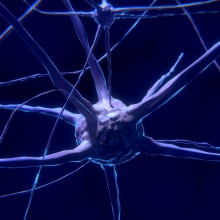Our brains run on electricity, but how does that electricity work to send messages around the body? Isabelle Cochrane gives us a tour of the body's information highways
In this episode

Naked Body: Getting on our nerves
Isabelle Cochrane
Our brains run on electricity, but how does that electricity work to send messages around the body? Isabelle Cochrane gives us a tour of the body's information highways
If you saw a bear, you’d run, wouldn’t you? Seems simple, but in order to make it work, your body has a fair bit to do: Your sensory organs are constantly scanning your environment for useful information about your surroundings – for example, your eyes pick up the visual signal that there’s a bear. Your ears hear a roar. This information then gets sent to your brain, the role of which is to coordinate a response: ‘oh dear, run’, which is carried out by the appropriate parts – your legs.
In order for all this to happen, there needs to be communication between the senses, the brain, and the bits responsible for the response. This is where nerves come in.
Nerves are bundles of elongated individual cells, called nerve fibres. Nerve fibres are very narrow, only a few thousandths of a millimetre thick, but they are very long. Nerves themselves, because they are made up of thousands of nerve fibres, are much thicker and are visible to the naked eye.
Despite being so small, nerve fibres can transmit information at more than 400km/h, well over the speed limit!
The only thing that can give the necessary speed and accuracy is electricity. Nerve fibres are long, thin tubes each made up of a cell membrane surrounding an electrically charged core. Around the fastest nerve fibres are layers of a fatty substance called myelin, the role of which is to insulate the nerve fibre – a bit like a plastic coating on an electrical wire.
Nerves can be activated either by external signals such as temperature, pressure, sound, light, or internally by other nerves. These activating signals are called ‘stimuli’. The exact way in which a nerve fibre is activated differs slightly based on the type of signal it is designed to detect.
For example, nerve fibres that detect touch have channels which open when the cell membrane is deformed due to the pressure exerted on it by an object touching the skin. Those which detect heat have channels which change shape with temperature, resulting in the channel opening.
When a channel opens, we get a flow of ions. This is an electrical current, which in turn has an effect on the voltage across the nerve fibre’s membrane. This sudden voltage change across the membrane of the nerve fibre causes nearby channels to open too, because they are voltage-sensitive. Then, like an electrical Mexican wave, more channels open near those ones, which will open ones further along. This leads to a progressive wave of activity spreading along the fibre. These electrical signals, which are called action potentials, travel along the length of the nerve. In this way, a signal can be transmitted from one end of the nerve fibre to the other.
When we talk about nerves, we often only think about the nerves in our arms and legs and fingers and toes - but remember, the nerve fibres your brain is made up of work in exactly the same way - so it’s nothing more than a bag of tiny electric cables, which branch and contact each other to form very complex circuits, continuously receiving information about the outside world from sensory receptors, processing this information and sharing signals to form a picture of the world around you.










Comments
Add a comment